THE SNAPSHOT
ƒ¢πΩAV researchers work closely with Nova Scotia‚Äôs wild blueberry farmers to develop the innovations the sector needs to succeed as climate impacts intensify. The university‚Äôs new Atlantic Institute for Digital Agriculture will focus and expand this work, delivering precision and digital technologies to help the province‚Äôs largest agricultural export continue to thrive.
THE CHALLENGE: Unruly crop, big stakes
When Nova Scotia farmer Peter Swinkels describes what it takes to bring wild blueberries to harvest, the enterprise takes on the tension of a bet not easily won. The crop has a mind of its own. It’s naturally occurring rather than planted in tidy rows. And since growth is managed over time, the crop can’t be quickly expanded to compensate for setbacks. In recent seasons, swings from excessive rain, to late frosts, to severe drought have left even the most experienced growers exposed to risks they have never seen before.
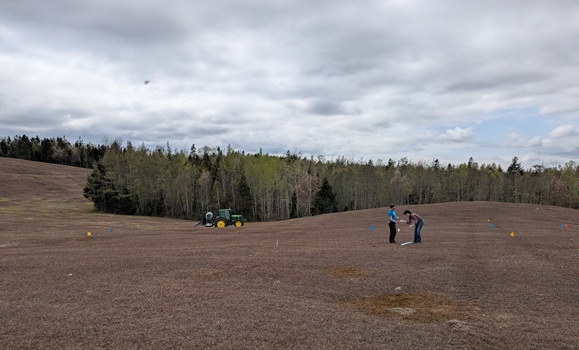
 Dal student researchers at work collecting data in wild blueberry field.
Dal student researchers at work collecting data in wild blueberry field.
“The fact of the matter is, we're suffering more extremes than we ever had in the past,” says Swinkels, who is also a past president of the . “To have a crop dry out like it did this year is unknown to us. So, it's really, really challenging to get this steady factor that we need to stay above cost of production.”
Wild blueberries grow on a two-year cycle. After harvest, farmers mow the bushes down to the ground. Over the next season, the plants regrow, and in late summer and early fall they produce buds that flower in spring and return fruit to fields in the second August.
During that long window the potential for trouble lurks. Excessive moisture kept machines out of fields two summers ago. This year brought the opposite. ‚ÄúJuly, August, provided only a fraction of the rain required,‚Äù says ƒ¢πΩAV engineering professor and researcher Dr. Travis Esau. ‚ÄúSome farmers literally did not harvest their crop because yields were so poor.‚Äù
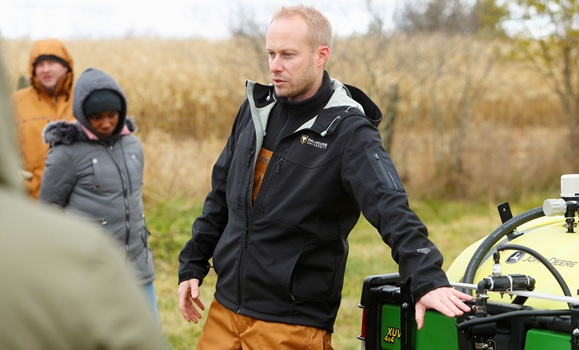
Dr. Travis Esau demonstrating equipment in the field
The economic stakes are high for such an unruly commodity. Nova Scotia’s wild blueberry sector produces more than 50 million pounds each year across more than 40,000 acres. With over 630 growers and more than $120 million in annual international sales, it is the province’s most significant agricultural export, making up a meaningful share of the rural economy that supports families and communities.
The farmers are resilient, pragmatic and entrepreneurial, but the combination of climate extremes, long crop cycles and increasing competition has created pressure that experience alone cannot account for. Swinkels says they need every advantage they can get to manage a crop that leaves them exposed for so long, with little margin for error.
THE SOLUTION: In-house R&D
For large global crops like corn and soy, farmers can rely on global manufacturers to build new tools and technologies. But wild blueberries grow in only a few select regions, most prominently Atlantic Canada, Quebec and Maine. The crop is too small to attract major R&D investment from multinational firms.
“It's a unique crop,” says Dr. Esau. “There are only wild blueberries in northeastern North America in any scale, so large manufacturers don't look at it as being big enough to justify developing and commercializing products that are only going to be sold to a very small group of people.”
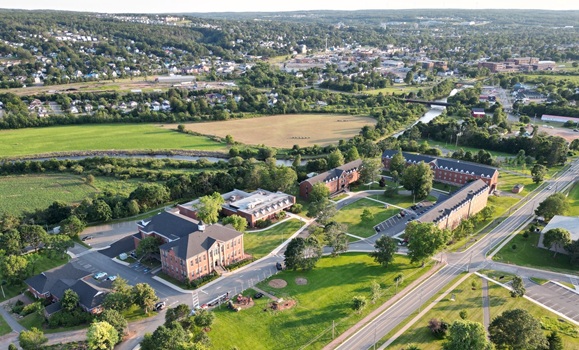
ƒ¢πΩAV‚Äôs Agricultural Campus in Truro, Nova Scotia
To support the industry, Dr. Esau and colleagues Drs. Scott White, David Percival and Christopher Cutler on Dal’s Agricultural Campus in Truro have stepped into this gap. They have become an in-house R&D engine for wild blueberry and other growers, engineering equipment and tuning digital tools and precision farming approaches to meet the needs of the province’s unique crops and terrain.
Now ƒ¢πΩAV is increasing its commitment to the province‚Äôs farmers with the launch of the Atlantic Institute for Digital Agriculture. Dr. Esau, its inaugural scientific director, says the institute will help to provide the region‚Äôs growers with field-ready support they need to stay competitive in the face of climate change and global pressures.
Swinkels says the increased collaboration is not just welcome, but essential, arguing that applied research has been the line between real progress and an uncertain future for his industry.
THE WORK: From AI tools to autosteer
Throughout the year, ƒ¢πΩAV researchers and students move through the rugged fields radiating out from Oxford, Nova Scotia, a location well known as the wild blueberry capital of Canada. They collect samples on their knees and fly drones overhead to test new AI-guided spraying techniques. In the lab, colleagues analyze soils, study genetic code, and build computer models. Together, they are mapping these ecosystems in fine detail to support precision agriculture ‚Äî data-driven farming tuned to nature‚Äôs exacting needs.
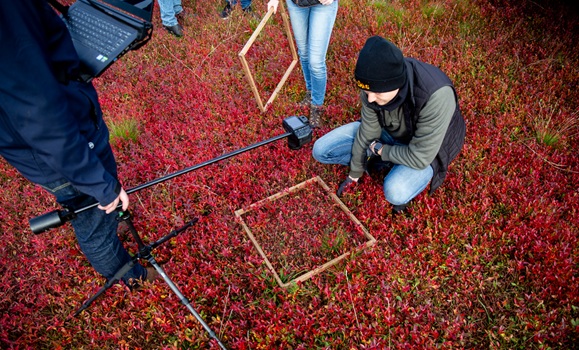
Collecting data leaf by leaf.
The goal is focused squarely on increasing the resilience of the sector. It’s the touchstone that guides all the projects Dr. Esau takes on. One of his lab's newest is a smartphone app geared to help farmers quickly spot issues in their fields.
Over 200 weed species are known to grow in wild blueberry fields, reflecting the diversity that shapes management decisions, says Dr. Esau. The plants appear in irregular patterns across rough, acidic ground, and the mix can be especially hard for new farm hands to parse. Esau’s point-and-shoot tool allows a farmer to identify select weeds in real time.
“You take a picture and right away, it tells you what the weed is and the best way to follow up — when to manage it, how to spray it,” says Swinkels. “It's been a real asset.”

Farmer Peter Swinkels uses a Dal-developed app to identify weeds
That simple action rests on a hard-won solution developed for the distinct demands of Nova Scotia’s wild blueberry crop. Esau’s team, with the help of Dal weed scientist Dr. White, gathered thousands of images from farms across the province and had students examine and label every leaf and stem. Those annotated images trained a neural network to see fields the way a veteran Nova Scotia grower does. The AI-driven technology can also trigger commands to turn sprayer nozzles on and off depending on where and what weeds are spotted. Work is underway to expand the mobile app for disease detection and to even count wild blueberry flower buds in real time.
Dr. Esau‚Äôs lab is also mapping fields from above using drones, collecting complex visual data to pick out stress zones the human eye can‚Äôt see. The information feeds maps showing the exact locations of weeds that need to be treated and helping farmers avoid the cost and environmental impact of widespread spraying. Much larger drones are being tested to replace heavy ground sprayers, offering moreÃ˝advanced automation in their application and preventing yield losses caused by driving over crops.
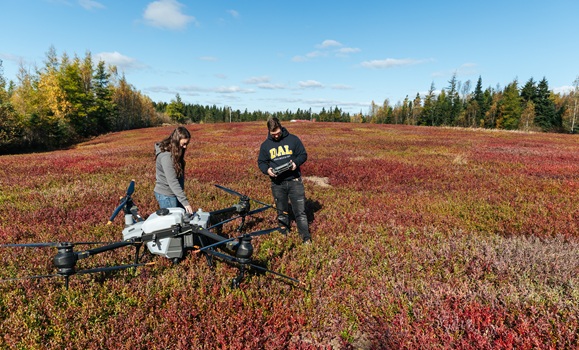
Prepping a drone for a research mission
The researcher is also helping to drive innovation in harvesting. Traditionally operators crept across fields at less than a mile an hour, continually adjusting their course, shifting the harvester picking reel, checking the fast-filling bins behind them, all while trying to keep a perfectly straight line. The natural faults of manual driving can result in missed berries, torn plants or overlapped ground. Dr. Esau research demonstrates the benefits of adapting GPS-assisted steering, locking tractors onto precise paths to avoid wasted passes and allowing the operator to focus on harvesting the fruit.
THE IMPACT: Innovation rooted in place
From GPS guided rows to drone flight paths, the pattern is the same. ƒ¢πΩAV researchers are working alongside farmers, translating the complexities of a naturally occurring crop into data, tools and decisions that work at the scale of a single patch of field. The partnership between farmers and researchers has become more than a collaboration. It is the reason the stubborn Nova Scotian crop continues to thrive.
“When I started back in the 80s, I would be bragging about a 2,000-pound-an-acre crop. Now, if I had 2000-pound crop, I would hang my head and not talk to anybody about it,” says Swinkels. “We've been able to get our crops up to six or 7000 pounds to the acre, and more. It's taken technology to get us there. And we have to get these good yields to be able to carry us through the disadvantages of our environmental conditions.”
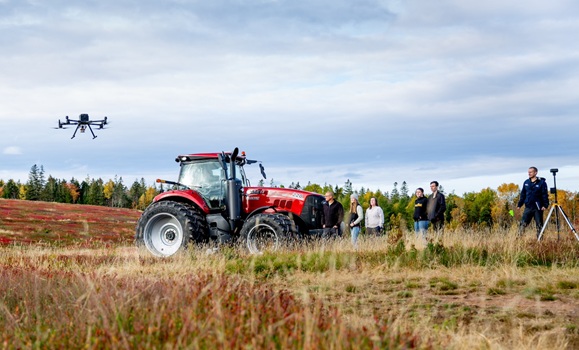
Dr. Esau (far right), colleagues and students take a drone for a test flight.
The creation of the Atlantic Institute for Digital Agriculture will ensure engineers and scientists will be attuned to every new challenge. Bringing together researchers from the Faculties of Agriculture, Science, and Computer Science, the institute will deliver solutions that fit the geography and diversity of Atlantic agriculture.
For Carolyn Van Den Heuvel, executive director at Nova Scotia Federation of Agriculture, the opportunity ahead is to build on an ecosystem already used to solving problems together. With farmers, government, industry and ƒ¢πΩAV researchers aligned, she sees the region as uniquely positioned to generate innovations that match its crops, climate and scale. She says it‚Äôs the advantage of having research rooted in place.
“There is real opportunity when we all come together,” she says. “We’re able to see openings for innovations that are right-sized solutions for our farms here in Nova Scotia. Without Dal being here, we would be relying on solutions that were not developed with Atlantic Canada in mind. It's pretty special.”
How it was funded
Dr. Esau’s project titled “Development of digital technologies for wild blueberry cropping system to lower production costs and increase berry quality” in partnership with the Wild Blueberry Producers Association of Nova Scotia was supported by a Mitacs Accelerate grant. This funding which fosters collaboration between university researchers and partner organizations in the private, public, or not-for-profit sectors to accelerate the application of research for Canadians’ benefit. Additional funding was provided by the Natural Sciences and Engineering Research Council of Canada’s Discovery Grants program.


